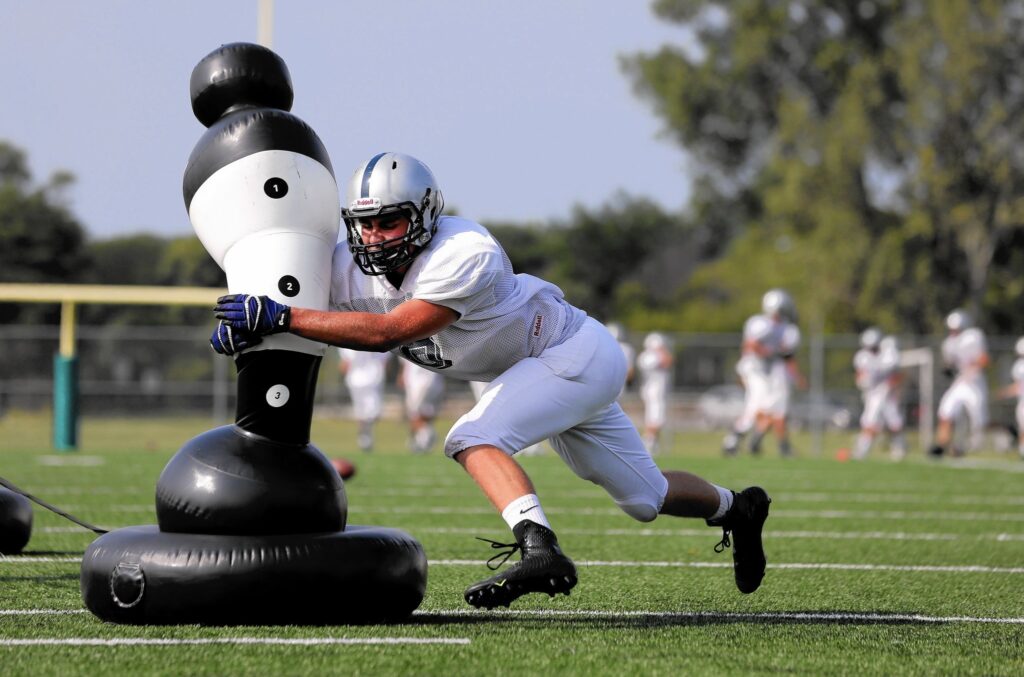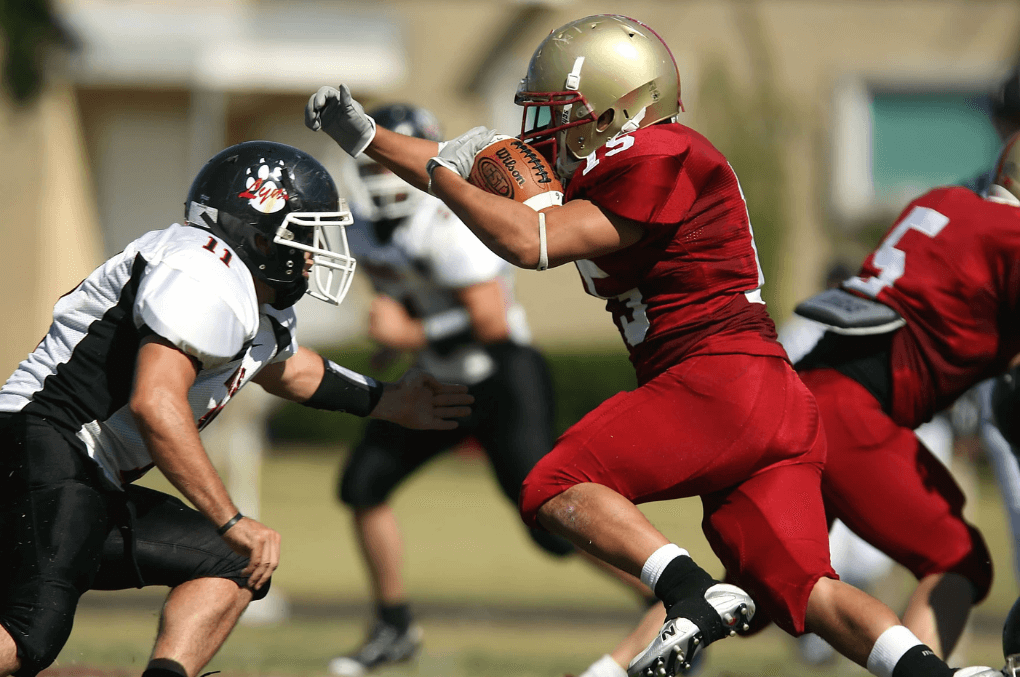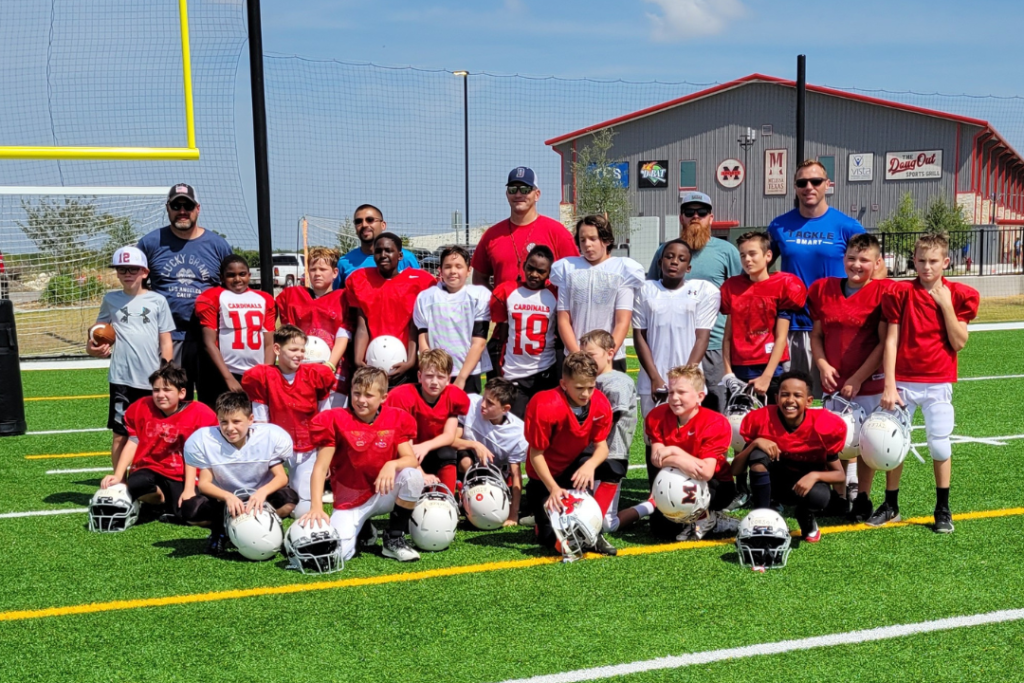The football off-season isn’t a time for players to rest on their laurels. Sure, taking some time off at the end of the season is important for recovery and to reduce the risk of burnout, but developing (and sticking to) an off-season workout program will help your child progress to the next level of their game. These programs aren’t easy – physically or mentally – but a child with the self-discipline to train during the off-season shows a football coach just how much playing the sport matters to them.
Here are some tips on areas of focus when helping your child develop an off-season workout plan.
Strength and Muscle Building
The off-season is the time to develop strength and muscle. During the season, the wear and tear of the body through games and practices, plus all the cardio involved in those processes, makes it almost impossible to find the time (or caloric intake) to develop muscle. The off-season, however, is the perfect time, with weight room sessions incorporated into an overall workout plan to help increase player maxes and help with repetitive strength techniques (such as blocking) on the field.
Players should concentrate on the big/compound five exercises. The beauty of these five techniques is that they maximize a player’s output by working multiple muscle groups simultaneously. This makes for a more effective workout than spending too much time focusing on improving one singular muscle.
The compound five are:
- Deadlift
- Bench Press
- Squat
- Shoulder Press
- Pull-Up
Despite all the improvements in exercise science and strength & conditioning over the years, sometimes the classics are the best. Get your child to understand and perfect each exercise above, and you immediately improve their efficiency in the gym.
Alongside these exercises, one area that we think is worthy of special attention is the neck. Many entries in this blog series have talked about concussion and concussion avoidance, and all studies point to a correlation between increased neck strength and a lower incidence of concussion. Help your child stay on the field by incorporating neck strengthening exercises into their basic workout routine daily.
Mobility
Historically the off-season was all about strength training. Today, many other game performance drivers need to find their way into what your child does during the off-season. One of those is to work on improving their mobility.
Mobility is the base on which the rest of your fitness attributes stand. Mobility training will help keep you flexible and strong, which is essential in injury prevention. Plenty of gym rats and workout warriors on the football field constantly get injured because they are too bulky. This is because they haven’t been working on their mobility alongside their gains in the gym.
At its most simple, increasing your child’s mobility is as simple as throwing in a stretching session for 15 minutes each day. Concentrate on all the major muscles throughout the week, working not only the legs but also the upper body and (importantly) twists. Professional athletes like Aaron Rodgers and LeBron James are famous for incorporating yoga into their training. Don’t be afraid to step into the unknown with your cold and visit a studio. You will be amazed at the benefits you both see from regular stretching.
Speed and Agility
They say you can’t teach speed. That is not true. While some elements of speed are natural, every child can learn to be faster by using speed and agility drills in their off-season program.
Football is an explosive game. Players that have explosive power are the ones that make game-changing plays. This isn’t just a thing for skill position players, as rush ends and offensive linemen can learn to hone their speed off of the ball on their first step to become much more effective players at every level.
Speed and acceleration training is also easy to do. All your child needs is some space where you can set up drills and a desire to be faster. Cones are great, but using items of clothing or other odds and ends found around the house work just as well. Certainly, work on your sprint speed and prioritize sprints with a maximum distance of 60 yards. This will be great for your kid’s explosive power. Also, make sure your child is working on their change of direction, as football is rarely played in a straight line. Being fast is great but useless if you don’t have the agility and ankle strength to cut past a defender or into space to catch a pass. Have your child work on exploding out of their cuts, changing direction, and hammering back up to their top speed as quickly as possible.
Conditioning
In season, players are often practicing daily. Add in games every week, and there might be one or two days a week (if that) where a child isn’t getting conditioning work in. That means that the sudden lack of cardio can be a big problem when the off-season hits. Gone are the days when coming into camp 20 pounds overweight and then losing the fat before the first game is acceptable. Aside from the game fitness, players are expected to be at their peak physical condition on Day 1, maximizing the time to train on skills and plays.
Condition is the easiest part of an off-season program. It is also the most boring unless you are one of those who loves running. Most football players prefer to sprint rather than clock mile after mile on the road or a track, but using that more extended form of running as a conditioning base will help your child keep their body fat down. As a bonus, this will also (hopefully) instill some love of running into them for when their metabolism disappears later in life!
Position Technique Training
The final area to look at during the off-season with your child is working on their game through techniques specific to their position. This isn’t always easy, often you will need to have your child playing with a couple of friends to make the most of this type of work, but always be on the lookout for training tools for any time your child wants to practice on their own.
The key to this off-season work is to keep it fun and safe. One area that we want to emphasize is to work on football tackle technique and tackle football training. Your kid might be a wide receiver or running back, but colleges are always looking for athletic players that can tackle to be on special teams. The correct tackle technique will not only promote safety but also ensure that your child has many more successful tackles during the season than players tackling using nothing but force. This website is a great resource for tackle football drills and on how to tackle safely, while getting your child into a camp with a specific focus on tackling will only make them better as a player (and make you more comfortable with their level of contact as a parent) moving forwards.
Those five areas of game fitness should be prioritized over the off-season. Add to this by encouraging your child to play other sports (especially at a young age) and watch their development compared to kids that do nothing but play video games for six months of the year.
Are you a parent or coach who wants to make sure your young athlete is being taught the safest and most effective tackling techniques? Then SIGN UP to our newsletter to stay up to date with our regular content, including upcoming events or camps!
Click HERE to sign up!




